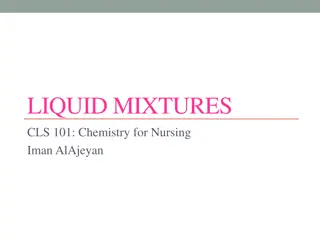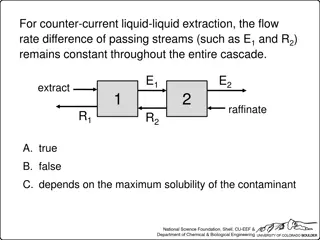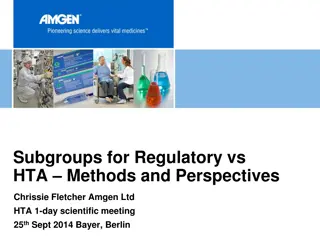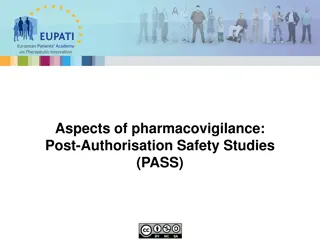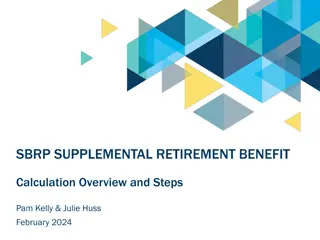Cost-Benefit Analyses for Liquid Biopsy Studies: Understanding Health Economics and Decision Making
Health economics and decision making play a crucial role in evaluating the clinical utility and cost-effectiveness of liquid biopsies. Economic models such as cost-effectiveness analyses help in determining the incremental cost-effectiveness ratio (ICER) of interventions. Studies have shown varying results regarding the cost-effectiveness of liquid biopsies in different cancer types, emphasizing the importance of rigorous evaluation before widespread implementation.
Download Presentation

Please find below an Image/Link to download the presentation.
The content on the website is provided AS IS for your information and personal use only. It may not be sold, licensed, or shared on other websites without obtaining consent from the author. Download presentation by click this link. If you encounter any issues during the download, it is possible that the publisher has removed the file from their server.
E N D
Presentation Transcript
Cost Benefit Analyses for Liquid Biopsy Studies December 16, 2021
Outline 1. Health Economics and Decision Making 2. Clinical Utility of Liquid Biopsies 3. Development of a Preliminary Liquid Biopsy CEA 4. Q&A
Health Economics and Decision Making
Health Economics and Economic Modeling Economic Models Models are simplifications of real world concepts or processes Models are created to view, manipulate, or test the thing that they represent A cost-effectiveness analysis (CEA) is a common type of health economic evaluation, typically used when comparing interventions or strategies Economic Evaluation The underlying goal in any health care decision is to attain maximal health benefit for a given budget [1] Health economics and health economic modeling provide an evidence-based framework to help make decisions under resource constraints. Healthcare decision making in the US currently does not formally consider such models, but most health plans and formulary managers do have an interest in economic evaluation and they still can influence clinical guidelines.[2] [1]. Ryder, H.F., et al., Decision Analysis and Cost-effectiveness Analysis. Seminars in spine surgery, 2009. 21(4): p. 216-222. [2]. Peter J. Neumann, S., Why Don"t Americans Use Cost-Effectiveness Analysis? The American Journal of Managed Care, 2004. 10(5).
Cost-Effectiveness Analyses Analyzes both costs and health outcomes of each intervention Used to aid in the decision making process for intervention adoption The main outcome of a CEA is the incremental cost-effectiveness ratio (ICER) ???????????????? ?????????????? ?????????????????? ???????????????? ???? =
Cost-Effectiveness of Liquid Biopsies Ijzerman et al. identified 3 early health economic studies which have evaluated the cost-effectiveness of liquid biopsies [1] 1. Degeling et al. concluded that there is potential to avoid overtreatment and reduce healthcare costs through the use of CTCs to determine progressive diseases in metastatic castration-resistant prostate cancer [2] 2. Kapoor et al. found that a cost of $200 would be cost-effective for an miRNA blood- based test to screen for gastric cancer [3] 3. S nchez-Calder n et al. found a comprehensive ctDNA panel to determine treatment resistance in HER2-positive breast cancer to be not cost-effective [4] [1] Ijzerman., et al., Towards Routine Implementation of Liquid Biopsies in Cancer Management: It Is Always Too Early, until Suddenly It Is Too Late. Diagnostics (Basel), 2021. 11(1). [2] Degeling, K., et al., Comparison of Timed Automata with Discrete Event Simulation for Modeling of Biomarker-Based Treatment Decisions: An Illustration for Metastatic Castration- Resistant Prostate Cancer. Value Health, 2017. 20(10): p. 1411-1419. [3] Kapoor, R., et al., Evaluating the Use of microRNA Blood Tests for Gastric Cancer Screening in a Stratified Population-Level Screening Program: An Early Model-Based Cost- Effectiveness Analysis. Value Health, 2020. 23(9): p. 1171-1179. [4] S nchez-Calder n, D., et al., Analysis of the Cost-Effectiveness of Liquid Biopsy to Determine Treatment Change in Patients with Her2-Positive Advanced Breast Cancer in Colombia. Clinicoecon Outcomes Res, 2020. 12: p. 115-122.
Current Evidence Ijzerman., et al., Towards Routine Implementation of Liquid Biopsies in Cancer Management: It Is Always Too Early, until Suddenly It Is Too Late. Diagnostics (Basel), 2021. 11(1).
Clinical Utility of Liquid Biopsies
Liquid Biopsy Advantages and Applications Applications [1] Cancer screening programs Improved tumor staging Response monitoring Treatment targeting following genomic profiling Advantages Noninvasive and an alternative for more inaccessible tumors Quicker Less expensive [1] Ijzerman., et al., Towards Routine Implementation of Liquid Biopsies in Cancer Management: It Is Always Too Early, until Suddenly It Is Too Late. Diagnostics (Basel), 2021. 11(1).
Cancer Screening Programs Routine Screening True Positive True Negative False Positive False Negative The use of liquid biopsies as a supplement in a cancer screening program would improve the sensitivity of the screening program. More true positive results and less false positives This translates to earlier detection, quicker treatment, better outcomes, and reduced imaging and diagnosis costs
Improved Tumor Staging Liquid biopsy generated evidence on micro metastasis Guides and informs systemic therapy Reductions in over and under treatment More optimal resource allocation
Response Monitoring Liquid biopsies can be used to initiate and serially monitor treatment response to inform decisions. [1] Changes in CTC or ctDNA levels thorugh serial monitoring is correlated with tumor size and survival outcomes offering prognostic benefits. [2] Potential Health Economic benefits: Inform treatment decisions or discontinuation Reduction in treatment related adverse event and improved outcomes [1] Ijzerman., et al., Health economic impact of liquid biopsies in cancer management. Expert Rev Pharmacoecon Outcomes Res, 2018. 18(6): p. 593-599. [2] Tay, T.K.Y. and P.H. Tan, Liquid Biopsy in Breast Cancer: A Focused Review. Arch Pathol Lab Med, 2021. 145(6): p. 678-686.
Development of a Preliminary Liquid Biopsy CEA in Breast Cancer
Model Goals Objective To provide a preliminary direct economic argument for the use of liquid biopsies in breast cancer diagnosis, staging, and response, through a simplistic decision analytic model. Hypothesis The use of liquid biopsies as a supplement to the current standard of care for breast cancer in diagnosis, tumor staging, and response will be cost-effective.
Early Conceptual Model Primary Outcomes Population Diagnostic Outcomes Diagnostics Treatment TP $ $ $ Personalized Treatment Liquid Biopsy Survival and HRQoL At Risk Individuals TN Cancer Patients $ FP $ $ $ Standard of Care Standard of Care Adverse Events $ FN $ Costs Survival and Quality of Life
Model Overview Model Type: Model Type: Decision analytic Markov model Population: Population: Healthy women eligible for breast cancer screening Time Horizon: Time Horizon: Lifetime Cycle Length: Cycle Length: 1-Year Intervention: Intervention: Liquid Biopsies Comparator: Comparator: Current standard of care (SOC) Screening: Screening: Annual mammography Staging: Staging: Tissue biopsy Response: Response: Conventional molecular target treatment
Breast Cancer Natural History Model Model Inputs Model Inputs Incidence Rates Transition rates Stage distribution Survival by stage and age Screening pattern Sensitivity estimates Costs HRQoL estimates Asymptomatic Breast Cancer Invasive Breast Cancer Cancer Free Cancer Death Other Death A review of the CISNET Model Registry served as a foundation for structural choices.[1] The CISNET-DFCI model was utilized as the basis for the current model due to its simplicity and ease of replication.[2] [1] CISNET Model Registry. [cited 2021; Available from: https://resources.cisnet.cancer.gov/registry/home/. [2] CISNET-DFCI (Dana-Farber). [cited 2021; Available from: https://resources.cisnet.cancer.gov/registry/packages/cisnet-dfci-dana-farber/#basics.
Breast Cancer Natural History Model ctDNA + Invasive Breast Cancer ctDNA - Patients in the invasive breast cancer stage are stratified by ctDNA status, guiding treatment and impacting outcomes, as well as costs.
Primary Assumptions The primary model assumptions are similar to those used in the CISNET-DFCI model: 1. Breast cancer is a progressive disease 2. Early detection reduces disease severity 3. Survival is dependent on whether the cancer is interval detected or screen detected 4. Screening sensitivity of mammography is dependent on age and breast density 5. Stratification of ctDNA allows for improvements in patient triaging leading to reductions in mortality and costs
Key Model Inputs Input Value Source Cost of liquid biopsy screening test $500 Expert estimate Cost of liquid biopsy therapeutic determination test $1800 Expert estimate Health state utility values 0.6 - 1.0 Mandelblatt et al. Discount rate (health and cost) 3% Standard Breast cancer incidence Age dependent SEER Cancer Statistics Review Breast cancer mortality Stage and age dependent SEER Cancer Statistics Review Background mortality Age dependent U.S. female life table (CDC) Time horizon Lifetime
Preliminary Model Results We identified moderate clinical benefits in terms of Life years and quality of life The liquid biopsy arm of the model had slightly higher testing costs. Therefore, preliminary estimates of an ICER were greater than the typical willingness to pay threshold of $100,000/QALY
General Implications There is currently substantial uncertainty in estimating the health economic potential of liquid biopsies [1] Key next step in modeling is to devote greater efforts to capturing clinical benefit There is great potential for liquid biopsies to reduce healthcare costs and improve patient outcomes Early stage models can help identify viable and cost-effective applications of liquid biopsies Further modeling efforts can help to identify the key drivers of cost-effectiveness, as well as optimal use cases for liquid biopsies Alternative funding models (e.g. bundled payments) may help with coverage of new tests [1] Ijzerman., et al., Towards Routine Implementation of Liquid Biopsies in Cancer Management: It Is Always Too Early, until Suddenly It Is Too Late. Diagnostics (Basel), 2021. 11(1).






















